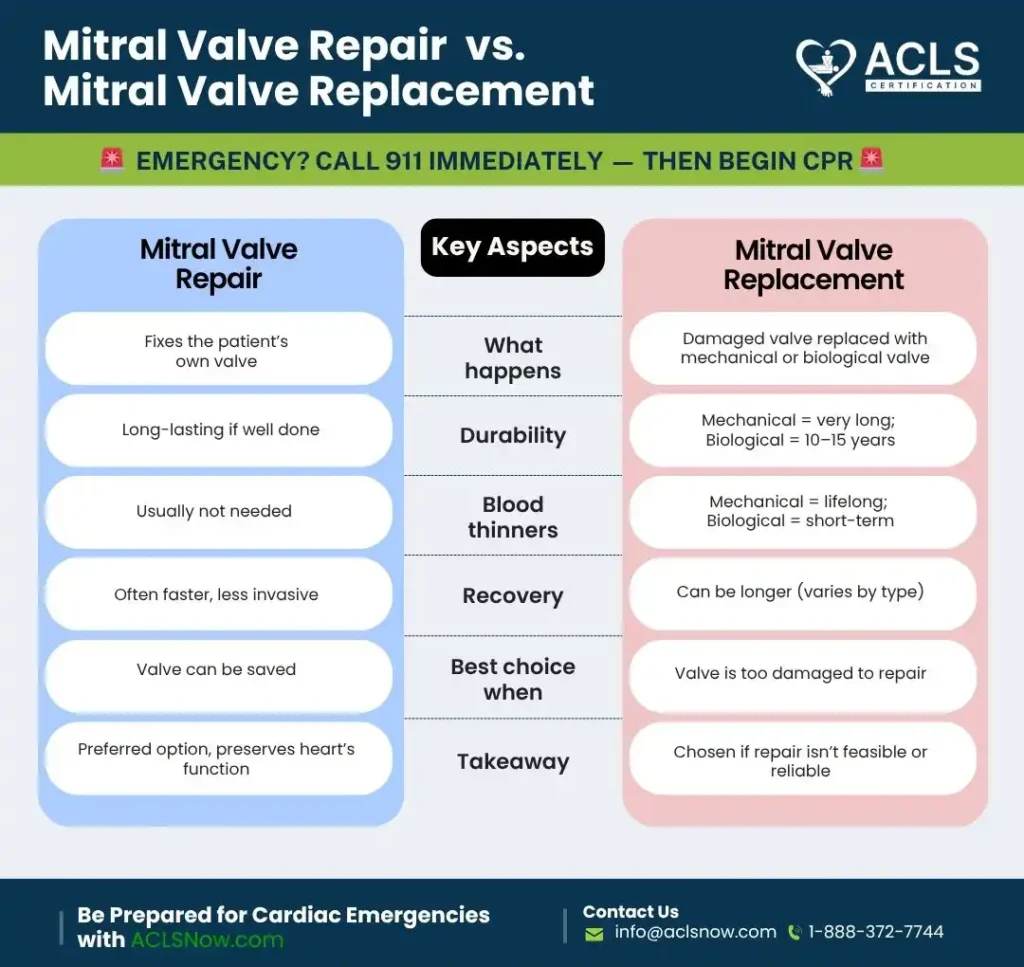The mitral valve is located between the left atrium and left ventricle to prevent the blood from flowing back to the atrium. However, when it does not close properly, blood flows backwards into the left atrium, which puts pressure on the heart. This condition is known as mitral valve regurgitation. This is a common problem that may occur suddenly or worsen over time. Globally, around 24 million people are affected by this condition.
Aging, heart disease, or certain infections can contribute to mitral valve regurgitation. Read on to learn more about mitral valve regurgitation, its symptoms, and the causes of this disease to understand its effects on heart health.
Master ACLS Now
Get ACLS certified with confidence
What is Mitral Valve Regurgitation?
The mitral valve is one of the four valves that govern blood flow in the heart. It only allows one-way blood movement and prevents backflow. If it is weakened or damaged, it cannot shut tightly, and blood flows back. In medical terms, this is called mitral valve regurgitation. The condition is also known as mitral incompetence or mitral insufficiency.
Trace mitral regurgitation or mild mitral regurgitation involves small backflows that may not cause symptoms. However, severe cases can stress the heart, reducing the amount of blood pumped to the body. This can lead to fatigue, shortness of breath, or an irregular heartbeat.
Mitral regurgitation can develop gradually over time (chronic) due to aging, heart disease, or valve degeneration. It can also happen suddenly (acute) due to events like a heart attack, infection, or trauma. If not treated timely, severe regurgitation can lead to serious complications such as heart failure or atrial fibrillation.
What Are The Types of Mitral Regurgitation?
The two main types of mitral regurgitation are primary (degenerative) and secondary (functional). They differ based on the underlying condition causing them, thereby affecting how well or poorly the mitral valve functions.
Primary (Degenerative) Mitral Regurgitation
In primary mitral regurgitation, the issue lies with the mitral valve itself. The valve’s leaflets, chordae (string-like parts), or papillary muscles are damaged or weakened. These muscles help the valve open and close properly. If they are damaged or weakened, the valve cannot close completely, allowing blood to leak back into the left atrium.
The most common causes of primary mitral regurgitation are infections, such as endocarditis, inflammation, or damage to the valve over time. This type also includes structural problems, such as a prolapsing valve, where the leaflets bulge backwards.
Secondary (Functional) Mitral Regurgitation
In secondary mitral regurgitation, the valve itself is normal, but other heart issues cause it to malfunction. Conditions such as heart failure, dilated cardiomyopathy (enlarged heart), or structural abnormalities in the left ventricle can stretch or distort the valve, preventing it from closing tightly and causing regurgitation.
What Are The Symptoms of Mitral Valve Regurgitation?
The symptoms of a leaking heart valve depend on the severity of the condition. In mild cases, patients may live symptom-free for years. However, as the disease progresses, mitral regurgitation symptoms become more apparent and may include:
- Shortness of Breath: Rapid onset of difficulty breathing due to fluid buildup in the lungs. This occurs with exertion or when lying flat.
- Fatigue: Reduced oxygenated blood flow to the body can result in persistent tiredness.
- Palpitations of The Heart: An irregular heartbeat (arrhythmia) or rapid palpitations may occur.
- Edema: Swelling in the legs, feet, or abdomen is common.
- Coughing: A persistent cough, especially when lying flat.
- Chest Pain: Though this is less common, some people will experience tightness in their chest or discomfort.
The symptoms of acute mitral regurgitation are more severe and may require emergency medical treatment. If symptoms such as sudden breathlessness or extreme fatigue occur, consulting a doctor is advised.
Additional Symptoms to Watch For
In advanced or severe cases, symptoms of left heart valve regurgitation may include:
- Waking up gasping for air
- Increased urination at night
- Weight gain due to fluid buildup
- A swollen jugular vein visible in the neck due to blood backing up
- Chest pain radiating to the neck or jaw
What Causes Mitral Valve Regurgitation?
Mitral valve regurgitation can result from several conditions based on whether the valve itself is damaged or if other parts of the heart are affected. Some of the common causes for this condition are detailed below:
Mitral Valve Prolapse
This common condition occurs when the valve’s flaps (leaflets) bulge backwards into the left atrium during a heartbeat. Over time, this weakens the valve, preventing it from closing completely and leading to leakage.
Rheumatic Fever
Untreated strep throat can lead to rheumatic fever, which may damage the mitral valve and cause scarring or deformities. This condition, known as rheumatic mitral valve disease, is now rare in developed countries.
Damaged Tissue Cords
The tissue cords, called chordee, hold the mitral valve flaps in place. Due to aging, mitral valve prolapse, or chest injuries, these cords can weaken, stretch or tear. A sudden rupture can cause severe regurgitation and may require surgical repair.
Heart Attack
A heart attack can damage the heart muscle that supports the mitral valve. Severe damage may lead to sudden and severe mitral regurgitation, known as ischemic mitral regurgitation, which requires urgent medical care.
Congenital Heart Defects
Some people are born with structural defects in the heart, such as faulty valves. These congenital defects can lead to mitral valve regurgitation, which may require medical intervention or surgery as the person ages.
Endocarditis
Endocarditis is a bacterial infection that inflames the inner lining of the heart, including its valves. Bacteria entering the bloodstream can attach to the valve, causing damage and leading to mitral valve regurgitation.
Radiation Therapy
Radiation therapy to the chest for cancer can sometimes damage the mitral valve over time, leading to regurgitation. Physicians must monitor this and intervene if necessary.
Other causes, including hypertension, Marfan syndrome, or chest trauma, can also contribute to the condition. The underlying cause often determines the treatment approach.
Read more: Heart Murmur: Causes, Symptoms, Treatment
Diagnosis of Mitral Valve Regurgitation
Doctors often begin diagnosing a leaky valve with a physical examination. Following the initial exam, additional tests are performed to confirm the diagnosis and assess the severity of the condition. Other diagnostic tests include:
Transthoracic Echocardiogram
This ultrasound test uses sound waves to create moving images of your heart. It’s the primary tool for diagnosing mitral regurgitation because it shows the valve’s structure and movement in real-time. It also measures how much blood is leaking backwards and reveals how the condition affects your heart’s function.
Electrocardiogram (ECG/EKG)
An electrocardiogram records the heart’s electrical activity using sensors placed on the chest. It helps identify irregular heart rhythms and patterns that may result from mitral regurgitation.
Chest X-ray
This imaging test provides a snapshot of the heart and lungs. Doctors use it to determine whether the heart is enlarged (a common consequence of mitral regurgitation) and to check for fluid buildup in the lungs, which may occur in severe cases.
Exercise Stress Test
During this test, patients exercise (usually on a treadmill) while doctors monitor heart activity. It evaluates how the heart performs under physical stress and can reveal symptoms that might not appear at rest. This information helps determine the severity of the condition.
Cardiac MRI
This advanced imaging test uses magnetic fields and radio waves to create detailed images of the heart. It provides precise measurements of the heart’s size and function. Cardiac MRI shows blood flow patterns clearly, helping doctors assess the extent of valve leakage with high accuracy.
Cardiac Catheterization
In this procedure, a thin tube is inserted through a blood vessel into the heart. Doctors measure pressures within the heart chambers and can inject dye to visualize blood flow patterns. This test is typically used when other tests are inconclusive or before planning surgery.
How is Mitral Valve Regurgitation Treated?
The treatment approach depends on the severity of the regurgitation and its effects on the heart. Mild mitral valve regurgitation might require immediate treatment but should be monitored regularly. Severe cases often need medical or surgical intervention. Common treatment options include:
Medications
Medications cannot repair the valve but can manage symptoms and prevent complications. Common examples include:
- Diuretics: Reduce fluid accumulation.
- Beta-blockers: Regulate heart rate.
- Anticoagulants: Prevent blood clots.
Surgical Choices
Surgery is necessary in advanced cases to repair or replace the mitral valve. The choice between valve repair and replacement depends on the extent of the damage. Common surgical options include:
Mitral Valve Repair
Mitral valve repair involves fixing the patient’s valve to restore proper function. This option is often preferred because it preserves the natural valve, improving long-term outcomes and reducing the need for lifelong blood thinners. Surgeons may tighten the valve, patch holes, or adjust its leaflets. It is less invasive and helps the heart function more effectively.
Mitral Valve Replacement
If repair isn’t possible, the damaged valve is replaced with a prosthetic valve. The surgeon may use mechanical or biological valves. Mechanical valves, made from durable materials like metal, last decades but require lifelong blood thinners. Biological valves, made from animal or human tissue, don’t require blood thinners but need replacement after 10–15 years. This approach is chosen for severely damaged valves.
Minimally Invasive Treatments
The surgeon may also recommend less invasive techniques, such as transcatheter edge-to-edge repair (TEER). This can be effective for some patients and may avoid the need for open-heart surgery. Early intervention can greatly impact the quality of life and prevent heart failure.
Read more: What Is Ejection Fraction and How Does It Relate to Heart Function?
Manage Mitral Valve Regurgitation With Timely Treatment!
Mitral valve regurgitation can be managed if found early. It varies from mild, when there is minimal backflow, to severe cases. New options, such as less invasive surgeries, can also be used for quick treatment to improve outcomes for many. You should consult a doctor immediately if you have symptoms of leakage in your heart valve or that of someone else. Moreover, if you wish to help people dealing with an emergency due to mitral valve regurgitation, you can also consider enrolling in advanced cardiac life support (ACLS) training.
FAQs
Is mitral valve regurgitation life-threatening?
Not always. Many people live for years with mild leakage and no symptoms. But severe cases can strain the heart and, if left untreated, may lead to heart failure. That’s why early diagnosis and regular checkups are important.
Can mitral valve regurgitation go away on its own?
No, a leaky valve doesn’t repair itself. Mild cases may not need treatment right away, but the condition usually progresses over time. Regular monitoring, medication or surgery is recommended depending on the severity.
What’s the difference between mitral valve prolapse and regurgitation?
Regurgitation indicates that the valve actually loses blood. Whereas mitral valve prolapse indicates that the flaps of the valve bulge backward. Regurgitation may occasionally, but not always, result from prolapse.
What lifestyle changes help manage this condition?
You can protect your heart by eating a heart-healthy diet, controlling your blood pressure, exercising, and abstaining from smoking. These can reduce the likelihood of problems, but won’t “fix” the valve.
When should I go to see a doctor?
Don’t hesitate to get checked if you experience breathing difficulties, exhaustion, chest pain, or leg swelling. It’s crucial to rule out valve issues as soon as possible, even if your symptoms seem slight.








